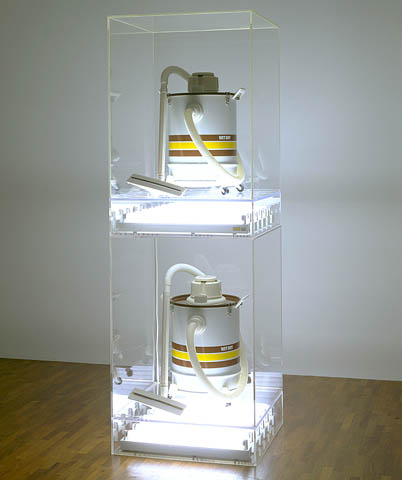The Crackers
After my venture two weeks ago into Central Park's conceptual art world, I felt that my views on The Gates had been disregarded and slighted by the larger art community. Looking for support, I turned to Anne, who, unfortunately for me, is majoring in art and specializing in sculpture... so she sees things a little differently than I do. Anne (of course) also checked out The Gates; she had a different reaction to the orange monstrosities: namely, she didn't think they were orange monstrosities. She found a walk among The Gates to be calming, much more calming than hearing about my plan to glitter Central Park and call it art.
Despite ostensibly pissing her off, I found our discussion of the art world pretty enlightening. As an art student, Anne's learned to engage with a piece of artwork simply as it is. Compare that to me, who, as a bitter Ivy League graduate with no job prospects, brings a lot of extra context to the art. For example, there's the $21 million price tag for The Gates, money which, without getting into the complexities of the issue, I'm sure could be put towards better use. To me, The Gates exemplifies everything I can't stand about our celebrity-worshipping mediocrity-approving dumb-fuck follow-the-leader pathetically ovine society. Like The Gates: it may be impressive in scope, but Christo made the project enormous in order to mask its utter lack of artistry. When I say "I could do that!" I don't mean I have the metalworking skills to construct such a project (I don't, and neither does Christo) but rather that I'm capable of producing the artistic vision embodied in the work.
The only thing The Gates has that my hypothetical glitter project lacks is the name of an "artist" attached to it, and it just seems like name-dropping shouldn't define art. Nowhere else in the world do people get away with this; if you go into heart surgery and come out with your leg amputated, the surgeon can't say, "Well, I'm a professional doctor, so it's okay that I needlessly cut your leg off."
It's with this background that I went to the Museum of Modern Art on Wednesday afternoon, where I came across the following. It's by some weenie named Jeff Koons, it's called New Shelton Wet/Dry Doubledecker, and it's only fitting that it gets a paragraph all to itself:

It's a vacuum cleaner in a glass box over fluorescent lights with — and here's the genius part — an identical vacuum cleaner in an identical glass box on top of it. Bernini is rolling over in his grave. Here's what the curators at the MoMA, who are clearly on crack, have to say about the vacuums:
Jeff Koons is one of countless artists whose work would not have taken the road it did without Warhol's precedent. [Another great artistic visionary. Soup. Gee, who'd have thought of that? — Jay] His art presents a profoundly ambiguous statement on American consumerism. New Shelton Wet/Dry Doubledecker (1981) deploys two identical professional-grade vacuum cleaners, illuminated by fluorescent lights and stacked iconically in plexiglass cases. Machines that exist to function have been neutered, vacuums placed in a vacuum — a status as self-contradictory as the machines' "wet dry" inscription. Koons presents without judgment the American fetishization of the new, the perfect. What could be cleaner than a new appliance, one intended to take in dirt but that will never be dirtied? Koons's presentation of these oddly anthropomorphic appliances takes no position — the work can be read as critique or celebration.Uh. Yeah. Whatever. Vacuum cleaners. Did anybody bother to parse that paragraph before plastering it on the museum wall?
What we really have here is some asshole who was paid a ridiculous sum of money to stack vacuum cleaners ("iconically," whatever that means) on top of each other, the MoMA's art psychobabble and doublespeak notwithstanding. Saying that Koons's so-called "statement on American consumerism" is "profoundly ambiguous" — not merely ambiguous but deeply, intensely ambiguous — is nothing but a rhetoric defense against the not-unfounded charge that New Shelton adds nothing to the discussion on American consumerism.
Q: Jeff, what exactly does New Shelton Wet/Dry Doubledecker say about the ways in which people, Americans in particular, consume?
A: Well, Mr. Art Critic, my statement on American consumerism is so profoundly ambiguous it can't be expressed in words. It can only be expressed through vacuums in boxes.
Just to be clear here, it's not like there aren't statements to be made about American consumerism. But perhaps the reason Koons's statement is so ambiguous is that he's not actually making one.
I don't understand it: I, for one, am actually expressing statements about the American way of life, and I haven't been contacted by a single artistic institution yet. Maybe if I started writing blather, I'd better further my career as an artist.
Koons presents "the American fetishization of the new, the perfect" because nothing could be cleaner than a new vacuum, but he presents that fetishization without judgment. He bravely "takes no position" on America's vacuum fetish. Indifference noted.
Now, I can present concepts in an indifferent and emotionless manner, too, if I want to. Example: calculus. Another example: today is Saturday. Another: some people like winter, others prefer summer. Where's my Genius Grant at?
Maybe Koons gets his vacuums in the museum by pulling off a trick even more self-contradictory than the machines' "wet dry" inscription (which, of course, isn't self-contradictory at all... it's a graphic design oversight and the inscription is supposed to read "wet/dry," with a slash) or the "vacuums in a vacuum" (again, not self-contradictory). Despite Koons's "[taking] no position" on his thesis and presenting the vacuums "without judgment," somehow the work nevertheless "can be read as critique." In case anyone from the MoMA happens to be reading this, the editor in me needs to point out that a critique, by definition, must take a position. I know it sounds all avant-garde and academic to say that something can be read as critique, but reading New Shelton as critique is even more pointless and non-sensical than Koons's statement on American consumerism.
That leaves reading the work as celebration. A non-judgmental celebration of the American fetishization of the clean, the perfect. Let's par-tay, bitches.
Me: ...but I could make that.
Mom: But you didn't make that.
Me: Well, if I'd known it would've gotten into a museum, I would have made it.

2 comments:
It's one thing to make art, it's another thing entirely to make art that deserves to be in a museum, the apotheosis of expression. Koons's vacuum cleaners easily qualify for the former, but I have nothing except contempt for his — and/or the MoMA's — desperate and nonsensical attempt to justify the latter.
Jay; you might not like this but the fact is that art is an expression of the "intelligentsia" of a society. This is; a very sophisticated word that means "the way society thinks".
The classics were certainly an expression of their society. So were Picasso and specially Dali, who had the amazing ability to paint as well and even better than most of the Spanish classics (Rafael, Velasquez, etc.) but choose not to. He was certainly a genius and his museum in Figueres, Spain, is a testament both to his amazing talent and his utter disregard for what most people, me and I think you included, expect art to be.
After visiting his museum and looking at his exquisite classic paintings together with some of the weirdest pieces I have ever seen in my life, I came out convinced that Dali’s message was that the destruction of art is also an expression of art.
Koon is an artist who depicts how low we have come and most important, an artist with a total lack of talent that is stuck in the destruction side of the artistic expression because he is obviously no Dali and certainly, no a genius.
It is a pity though, that the MoMa, a museum that I cherish, tries to make sense from something that has no sense. It would have been better for them just to say; “modern artist lost in a crevasse of art expression”.
Post a Comment